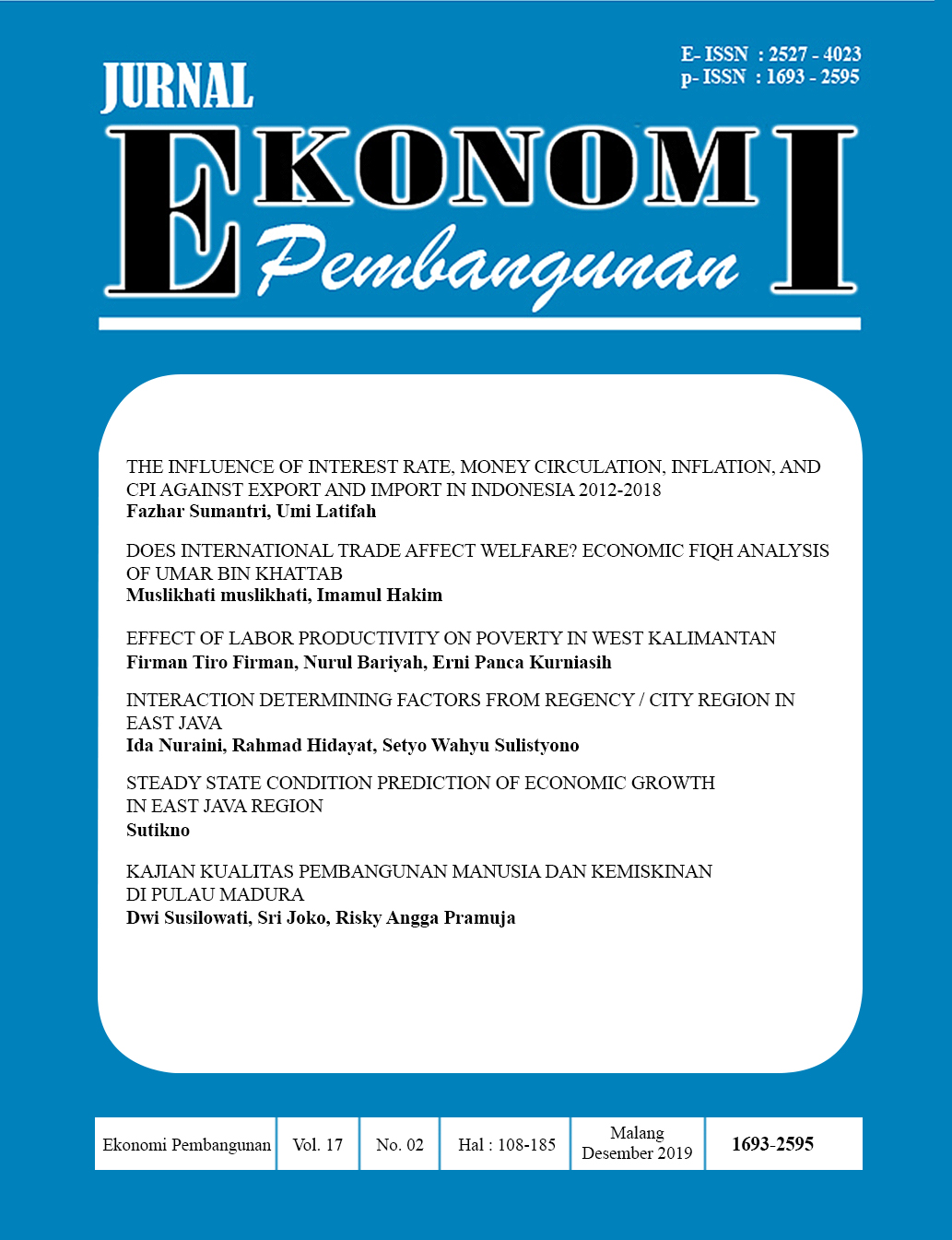ANALYSIS OF THE CHARACTERISTICS AND DEVELOPMENT DISPARITIES AMONG DISTRICTS/CITIES IN EAST NUSA TENGGARA PROVINCE
DOI:
https://doi.org/10.22219/jep.v17i2.10558Keywords:
Characteristics, Disparities, Klassen Typology, Williamson IndexAbstract
This study aims to review the regional characteristics and the development disparities among districts/cities in East Nusa Tenggara Province. This quantitative descriptive study used the Klassen typology and Williamson index using PDRB time-series data per capita and economic growth rate during 2013-2018. The analysis of Klassen typology shows that Kupang City, East Flores Regency, Sikka Regency, and Ende Regency include the developing and fast-growing regions. Kupang Regency, Timur Tengah Selatan Regency, East Sumba Regency include in the developing, but depressed regions. Belu Regency, Alor, Lembata, Manggarai, Ngada, West Manggarai, Rote Ndao, East Manggarai, Southwest Sumba, Malacca, Nagekeo, Central Sumba, and Sabu Raijua District including in the potential and fast-growing areas, while West Sumba Regency and Regency North Middle East are categorized in the underdeveloped regions. The calculation of the Williamson Index of districts/cities in East Nusa Tenggara Province is approximately 0.0 - 0.11 in every district. This shows that the revenue of East Nusa Tenggara Province is evenly distributed in every district, except Kota Kupang which of value is nearly 1, which is 0.63%. This reflected that the revenue of Kupang City is not evenly distributed compared to other districts in Nusa Tenggara Timur Province.
Downloads
References
Barker, T., Ekins, P., & Foxon, T. (2007). The macro-economic rebound effect and the UK economy. Energy Policy. https://doi.org/10.1016/j.enpol.2007.04.009
Daryanto, A. (2003). The disparity of Urban-Rural Areas in Indonesia. Agrimedia.
Noor, D. J. (2011). Research Methodology: Undergraduate Thesis, master’s Thesis, Dissertation, and Scientific Papers. In Metodologi Penelitian: Skripsi, Tesis, Disertasi, & Karya Ilmiah.
Dhyatmika, K. W. (2013). The Analysis of Development Inequality in Banten Province After the Division from West Java. Http://Eprints.Undip.Ac.Id/38984/.
Ekonomi, K., Berkembang, N., & Brata, A. G. (2002). Developmental Economy Journal, Human Development and Regional Economy Achievement in Indonesia. JEP.
Franita, R. (2016). The Analysis of Unemployment in Indonesia. Jurnal Ilmu Sosial.
Krinantya, N. (2014). Factors Affecting Inequality among the Regions in East Java Province and Yogyakarta Special Region. Http://Eprints.Undip.Ac.Id/43107/.
Kumala, M., Soelistyo, A., & Nuraini, I. (2017). The Analysis of Tourism Sector Potency as a Superior Sector in East Java. Ilmu Ekonomi.
Mankiw. (2013). Mankiw Principles of Economics. In Journal of Chemical Information and Modeling. https://doi.org/10.1017/CBO9781107415324.004
Mopangga, H. (2011). The Analysis of Development and Economy Growth Inequality in Gorontalo Province. Trikonomika.
Muhammad, D. S. H. (2018). Model of national Income Calculation in the Perspectives of Islamic Economy. Jurnal CMES. https://doi.org/10.20961/cmes.11.2.26996
NUSA TENGGARA TIMUR in Numbers 2013 - 2018, Statistics Bureau.
Nuraini, I. (2017). The Quality of Economic Development in the Regencies in East Java. Jurnal Ekonomi Pembangunan.
Pangkiro, H. A. K., Rotinsulu, D. C., Patrick, D., Jurusan, W., Pembangunan, E., Ekonomi, F., & Bisnis, D. (2016). The Analysis of Economic Development and Poverty on the Inequality in North Sulawesi Province. The Analysis of Growth Economic and Poverty on the Level of Inequality in North Sulawesi. Jurnal Berkala Ilmiah Efisiensi.
Pelling, M., Özerdem, A., & Barakat, S. (2002). The macro-economic impact of disasters. Progress in Development Studies. https://doi.org/10.1191/1464993402ps042ra
Syahrum., S. (2014). Quantitative Research Methodology. Komunikasi Penelitian Kuantitatif Program Studi Jurnalistik & Humas.
Downloads
Published
Issue
Section
License
Authors who publish with Jurnal Ekonomi Pembangunan (JEP) agree to the following terms:
- For all articles published in Jurnal Ekonomi Pembangunan (JEP), copyright is retained by the authors. Authors permit the publisher to announce the work with conditions. When the manuscript is accepted for publication, the authors agree to the publishing right's automatic transfer to the publisher.
- Authors retain copyright and grant the journal right of first publication with the work simultaneously licensed under a Creative Commons Attribution-NonCommercial-ShareAlike 4.0 International License that allows others to share the work with an acknowledgment of the work's authorship and initial publication in this journal.
- Authors can enter into separate, additional contractual arrangements for the non-exclusive distribution of the journal's published version of the work (e.g., post it to an institutional repository or publish it in a book), with an acknowledgment of its initial publication in this journal.
- Authors are permitted and encouraged to post their work online (e.g., in institutional repositories or on their website) before and during the submission process, as it can lead to productive exchanges and earlier and greater citation of published work (See The Effect of Open Access).

This work is licensed under a Creative Commons Attribution-NonCommercial-ShareAlike 4.0 International License.






















